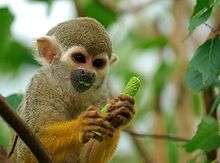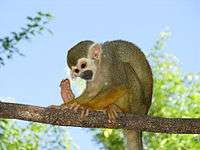Squirrel monkey
| Squirrel monkeys[1] | |
|---|---|
 | |
| Common squirrel monkey | |
| Scientific classification | |
| Kingdom: | Animalia |
| Phylum: | Chordata |
| Class: | Mammalia |
| Order: | Primates |
| Suborder: | Haplorhini |
| Infraorder: | Simiiformes |
| Family: | Cebidae |
| Subfamily: | Saimiriinae Miller, 1912 (1900) |
| Genus: | Saimiri Voigt, 1831 |
| Type species | |
| Saimiri sciureus | |
| Species | |
| Synonyms | |
Squirrel monkeys are New World monkeys of the genus Saimiri. They are the only genus in the subfamily Saimirinae. The name of the genus is of Tupi origin (sai-mirim or gai-mbirin < sai 'monkey' and mirim 'small')[3][4] and was also used as an English name by early researchers.[5][6]
Squirrel monkeys live in the tropical forests of Central and South America in the canopy layer. Most species have parapatric or allopatric ranges in the Amazon, while S. oerstedii is found disjunctly in Costa Rica and Panama.
The common squirrel monkey is captured for the pet trade and for medical research[7] but it is not threatened. Two squirrel monkey species are threatened: the Central American squirrel monkey and the black squirrel monkey are listed as vulnerable by the IUCN.[8][9]
Evolutionary history

Taxonomy
Until 1984, all South American squirrel monkeys were considered part of a single widespread species, and many zoologists considered the Central American squirrel monkey to be a member of that single species as well.[1][10] The two main groups currently recognized can be separated by the white above the eyes; it is shaped as a Gothic ("pointed") arch in the S. sciureus group, while it is shaped as a Roman ("rounded") arch in the S. boliviensis group.[11]
- Genus Saimiri
- S. sciureus group
- Central American squirrel monkey, Saimiri oerstedii
- Black-crowned Central American squirrel monkey, Saimiri oerstedii oerstedii
- Grey-crowned Central American squirrel monkey, Saimiri oerstedii citrinellus
- Common squirrel monkey, Saimiri sciureus
- Saimiri sciureus sciureus
- Saimiri sciureus albigena
- Humboldt's squirrel monkey, Saimiri sciureus cassiquiarensis
- Ecuadorian squirrel monkey, Saimiri sciureus macrodon
- Bare-eared squirrel monkey, Saimiri ustus
- Central American squirrel monkey, Saimiri oerstedii
- S. boliviensis group
- Black-capped squirrel monkey, Saimiri boliviensis
- Bolivian squirrel monkey, Saimiri boliviensis boliviensis
- Peruvian squirrel monkey, Saimiri boliviensis peruviensis
- Black squirrel monkey, Saimiri vanzolinii
- Black-capped squirrel monkey, Saimiri boliviensis
- Fossil species
- †Saimiri annectens, Honda Group, Kay and Meldrum 1997[2]
- †Saimiri fieldsi, Honda Group, Stirton 1951[2]
- S. sciureus group
Evolution
The crown lineage of the extant squirrel monkeys appears to have diverged around 1.5 million years ago.[12] S. boliviensis appears to be the first diverging species in the group. S. oerstedii and S. s. sciureus, are sister species. S. s. macrodon is the sister species to the S. oerstedii / S. s. sciureus clade.
Description
Squirrel monkey fur is short and close, coloured black at the shoulders and yellowish orange on its back and extremities. The upper parts of their heads are hairy. This black-and-white face gives them the name "death's head monkey" in several Germanic languages (e.g., German Totenkopfaffen, Swedish dödskalleapor, Dutch doodshoofdaapjes) and Slovenian (smrtoglavka).
Squirrel monkeys grow from 25 to 35 centimetres (9.8 to 13.8 in) long, plus a 35 to 42 centimetres (14 to 17 in) tail. Male squirrel monkeys weigh 750 to 1,100 grams (26 to 39 oz). Females weigh 500 to 750 grams (18 to 26 oz). Both males and females are equipped with long and hairy tails, flat nails, and pointed claws.[13]
Female squirrel monkeys have pseudo-penises, which they use to display dominance over smaller monkeys, in much the same way that the male squirrel monkeys display their dominance.
Behaviour and ecology
Like most of their New World monkey relatives, squirrel monkeys are diurnal and arboreal. Unlike other New World monkeys, their tail is not used for climbing but as a kind of "balancing pole" and also as a tool. Their movements in the branches can be very rapid.
Squirrel monkeys live together in multi-male/multi-female groups with up to 500 members. These large groups, however, can occasionally break into smaller troops. The groups have a number of vocal calls, including warning sounds to protect the group from large falcons, which are a natural threat. Their small body size also makes them susceptible to predators such as snakes and felids. For marking territory, squirrel monkeys rub their tail and their skin with their own urine.
Squirrel monkeys are omnivores, eating primarily fruits and insects. Occasionally, they also eat seeds, leaves, flowers, buds, nuts, and eggs.
Squirrel monkey mating is subject to seasonal influences. Females give birth to young during the rainy season, after a 150- to 170-day gestation. Only the mothers care for the young. Saimiri oerstedti are weaned by 4 months of age, while S. boliviensis are not fully weaned until 18 months old. Female squirrel monkeys reach sexual maturity at age 2–2.5 years, while males take until age 3.5–4 years. They live to about fifteen years old in the wild, and over twenty years in captivity. Menopause in females probably occurs in the mid-teens.[14]
Colour vision
Colour vision in squirrel monkeys has been extensively studied as a stand-in for human ailments.[15] In humans, two genes for colour vision are found on the X chromosome. Typically, one gene (OPN1LW) produces a pigment that is most sensitive to the 564 nm wavelength, while the other gene (OPN1MW) produces a pigment most sensitive to 534 nm. In squirrel monkeys, there is only one gene on the X chromosome but it exists in three varieties: one is most sensitive to 538 nm, one to 551 nm, and one to 561 nm. Since males have only one X chromosome, they are dichromatic, although with different sensitivities. Females have two X chromosomes, so some of them can have copies of two different alleles. The three alleles seem to be equally common, leading to one-third of females being dichromatic, while two-thirds are trichromatic.[16] Recently, gene therapy has given the human OPN1LW gene to adult male squirrel monkeys, producing behaviour consistent with trichromatic colour vision.[15]
Gallery
 At the Phoenix Zoo
At the Phoenix Zoo At the Phoenix Zoo
At the Phoenix Zoo At the Fuji Safari Park, Japan
At the Fuji Safari Park, Japan At the Phoenix Zoo
At the Phoenix Zoo At Ubon Zoo, Thailand
At Ubon Zoo, Thailand
References
- 1 2 Groves, C.P. (2005). Wilson, D.E.; Reeder, D.M., eds. Mammal Species of the World: A Taxonomic and Geographic Reference (3rd ed.). Baltimore: Johns Hopkins University Press. pp. 138–139. ISBN 0-801-88221-4. OCLC 62265494.
- 1 2 3 4 Saimiri - Paleobiology Database
- ↑ Simpson, George Gaylord. 1941. "Vernacular Names of South American Mammals." In Journal of Mammalogy 22(1): 1-17.
- ↑ Squirrel monkeys
- ↑ Palmer, T. S. 1897. "Notes on the Nomenclature of Four Genera of Tropical American Mammals." Proceedings of the Biological Society of Washington 11: 173–174.
- ↑ Leclerc, Georges-Louis, Comte de Buffon. "The Saimiri." In: Barr's Buffon. Buffon's Natural History',' pp. 251-252. London: J. S. Barr.
- ↑ Rhines, C. (2000). "Saimiri sciureus", Animal Diversity Web. Accessed November 26, 2007
- ↑ Boubli, J.-P. & Rylands, A.B. (2008). "Saimiri vanzolinii". The IUCN Red List of Threatened Species. IUCN. 2008: e.T19839A9023022. doi:10.2305/IUCN.UK.2008.RLTS.T19839A9023022.en. Retrieved 23 December 2017.
- ↑ Wong, G.; Cuarón, A.D.; Rodriguez-Luna, E. & de Grammont, P.C. (2008). "Saimiri oerstedii". The IUCN Red List of Threatened Species. IUCN. 2008: e.T19836A9022609. doi:10.2305/IUCN.UK.2008.RLTS.T19836A9022609.en. Retrieved 23 December 2017.
- ↑ Michael Kavanagh (1983). A Complete Guide to Monkeys, Apes and Other Primates. p. 84. ISBN 0-224-02168-0.
- ↑ Rowe, N. (1996). The Pictorial Guide to the Living Primates. Pogonia Press, Charlestown, Rhode Island. ISBN 0-9648825-0-7.
- ↑ Chiou KL, Pozzi L, Lynch Alfaro JW, Di Fiore A. (2011) Pleistocene diversification of living squirrel monkeys (Saimiri spp.) inferred from complete mitochondrial genome sequences. Mol Phylogenet Evol.
- ↑ "77". Organic Evolution. New York: The Macmillan Company. 1921.
- ↑ Walker ML, Anderson DC, Herndon JG, Walker LC (2009). "Ovarian aging in squirrel monkeys (Saimiri sciureus)". Reproduction. 138 (4): 793–799. doi:10.1530/REP-08-0449. PMID 19656956.
- 1 2 Mancuso, Katherine; Hauswirth, William W.; Li, Qiuhong; Connor, Thomas B.; Kuchenbecker, James A.; Mauck, Matthew C.; Neitz, Jay; Neitz, Maureen (2009-09-16). "Gene therapy for red–green colour blindness in adult primates". Nature. 461 (7265): 784–787. doi:10.1038/nature08401. ISSN 0028-0836. PMC 2782927.
- ↑ Jacobs GH, Neitz J (April 1987). "Inheritance of color vision in a New World monkey (Saimiri sciureus)". Proc. Natl. Acad. Sci. U.S.A. 84 (8): 2545–9. doi:10.1073/pnas.84.8.2545. PMC 304691. PMID 3470811.
External links
| Wikispecies has information related to Saimiriinae |
| Wikispecies has information related to Saimiri |
| Wikimedia Commons has media related to |